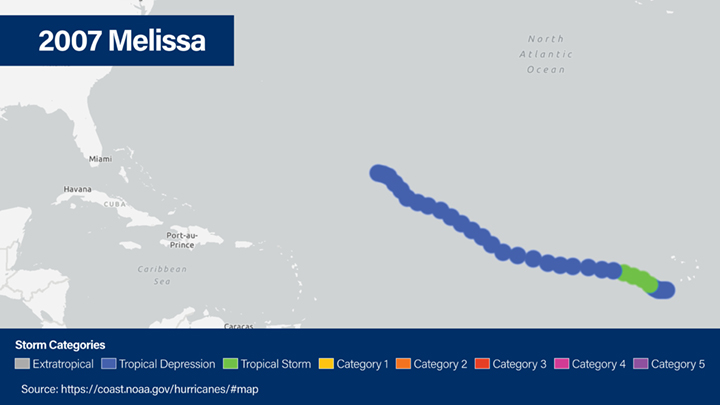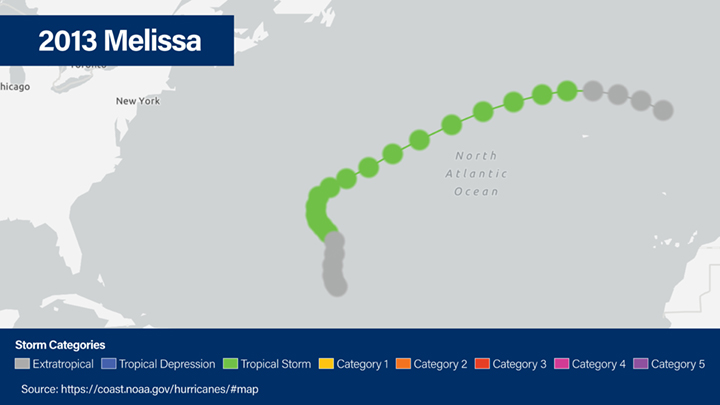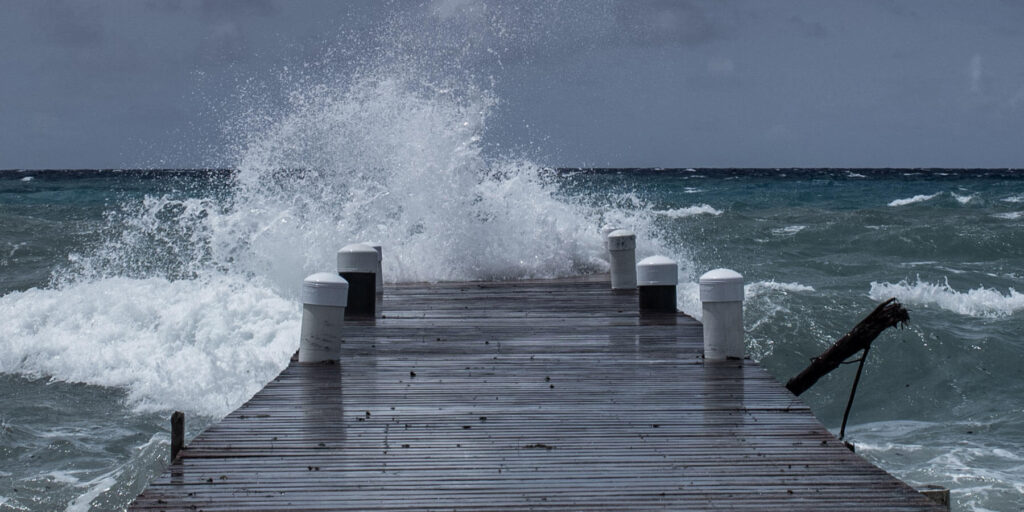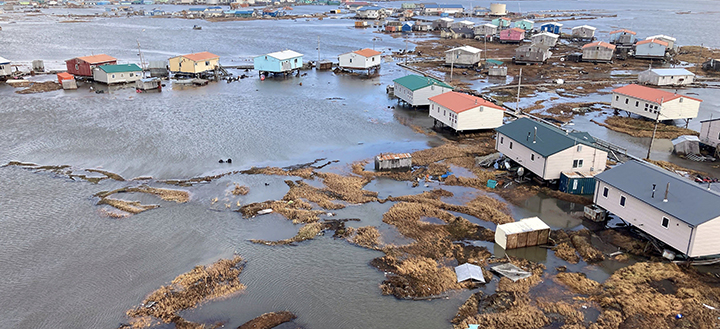The name Melissa has been used for multiple tropical storms since its introduction to the list of World Meteorological Organization (WMO) storm names. This year, it is the 13th name on the 2025 Atlantic hurricane season list.
Although a potential 2025 Tropical Storm or Hurricane Melissa would not be influenced by the characteristics of previous storms named Melissa, examining its past occurrences can give us some interesting insights and potentially enhance our preparedness efforts if/when it forms.
Below we’ll examine the formation patterns and meteorological details of Tropical Storm Melissa in 2007, 2013, and 2019 while also exploring preparations and safety strategies for 2025 Tropical Storm Melissa or Hurricane Melissa.
Historical Overview of Tropical Storms Named Melissa
Tropical Storm Melissa (2007)

- Formation: 2007 Tropical Storm Melissa began as a tropical wave off the western coast of Africa in late September 2007. It quickly organized and was classified as a tropical depression on September 28, later strengthening into a tropical storm.
- Intensity: The storm reached peak sustained winds of 40 mph (35 knots) and a minimum central pressure of 1005 millibars.
- Path and Impacts: It remained over open waters in the eastern Atlantic, moving westward toward the Cape Verde Islands, before dissipating on September 30, 2007. Melissa did not significantly affect land, and no casualties or damages were reported.
Tropical Storm Melissa (2013)

- Formation: 2013 Tropical Storm Melissa emerged from a non-tropical system over the central Atlantic Ocean in November 2013. It transitioned from a subtropical to a tropical storm, highlighting the dynamic nature of storm evolution.
- Intensity: It attained maximum winds of 63 mph (about 55 knots) with a minimum pressure of 982 millibars.
- Path and Impacts: Melissa moved northeastward, passing near the Azores. Strong winds and large swells impacted the Azores, but no significant damage was reported.
Tropical Storm Melissa (2019)

- Formation: The 2019 iteration of Tropical Storm Melissa developed off the U.S. East Coast in October 2019 as a subtropical system. It transitioned into a tropical storm while meandering southeast of New England.
- Intensity: Melissa peaked with sustained winds of 64 mph (about 55 knots) and a pressure of 994 millibars before dissipating.
- Path and Impacts: Although the storm remained offshore, it caused minor to moderate coastal flooding from North Carolina to New England due to storm surge and high tides.
Comparing Formation Trends and Characteristics
The storms named Melissa show a range of development patterns that reflect the variety of storm behavior in the Atlantic basin. Although they shared the name and all remained offshore, their origins, timing, and structure differed in several ways.
One key difference is the environment in which each storm formed. The 2007 system developed from a tropical wave in the deep tropics, following a more traditional path seen during the peak of hurricane season. On the other hand, the 2013 and 2019 Tropical Storm Melissa systems began as non-tropical or subtropical systems. These later storms formed farther north and during the latter part of the season, when cooler waters and shifting atmospheric conditions tend to support mixed tropical and extratropical features.
Timing also varied. 2007’s Tropical Storm Melissa appeared in late September, during the height of seasonal activity. The 2013 and 2019 storms formed in November and October, respectively, outside the core months when tropical cyclone activity is most frequent. This shift in timing may influence how these systems evolve, often involving more interaction with mid-latitude weather systems.
In terms of structure, the 2013 and 2019 versions showed characteristics typical of subtropical or transitioning storms. They featured broad wind fields and less defined cores early in their life cycles. These traits often make them more likely to generate large ocean swells, even when they remain distant from land. The 2007 storm, by contrast, stayed compact and more symmetrical, with less reach beyond its immediate area.
Although none of the Melissa storms became hurricanes, the 2013 and 2019 systems reached higher peak intensities and underwent more complex changes in form.
Tips to Get Ready for Tropical Storm/Hurricane Melissa
Individual and Community Safety Measures
Coastal communities should monitor storm surge forecasts and use elevation maps to make informed evacuation decisions.
Homeowners can enhance safety by maintaining hurricane shutters and fortifying roofs to withstand gusty winds. It’s also essential to have a well-stocked emergency kit with a 7-day supply of water, non-perishable food, medications, and local shelter maps.
Organizational Strategies
For organizations, especially those operating in critical sectors like energy, healthcare, or logistics, implementing Continuity of Operations Plans (COOP) is essential to maintaining business resilience.
These plans ensure that essential functions can continue during and after emergencies, safeguarding operations, and minimizing downtime. Reviewing and regularly updating IT disaster recovery plans is also a key component, as it helps prevent data loss, protects sensitive information, and helps systems be restored quickly and reduce disruptions.
Staying Prepared for More Melissa Storms
Looking back at the history of Tropical Storm Melissa shows how important accurate forecasting, strong planning, and clear public communication continue to be. Advances in meteorology help improve community safety while expanding our understanding of how these systems develop and behave.
With preparation and public awareness, regions at risk from tropical storms can strengthen their ability to manage future events, whether named Melissa or otherwise. For detailed guidance on hurricane readiness, look into resources from NOAA, like their Seven-Day Graphical Tropical Weather Outlook, or reach out to us to prepare for hurricane season.
FAQs About Tropical Storm/Hurricane Melissa
Has there ever been a hurricane named Melissa?
None of the Melissa storms have reached hurricane status due to environmental factors such as wind shear and cooler ocean temperatures during their formations.
How are tropical storms named Melissa?
The World Meteorological Organization assigns names like Melissa following a rotating list of predetermined names which are reused every six years unless the name is retired.
Should I be concerned about a storm named Melissa forming in the future?
While past storms named Melissa have generally been moderate in intensity, every tropical system has the potential to be dangerous. Always stay informed and treat each storm with caution.
What is a subtropical storm?
Subtropical storms like Melissa (2013 and 2019) exhibit characteristics of both tropical and non-tropical systems and typically have a broader wind field, with convection often farther from the center.
What were the effects of 2019 Tropical Storm Melissa?
Though it did not make landfall, Melissa caused minor to moderate flooding and beach erosion along the U.S. East Coast, underscoring potential impacts from offshore storms.
What is the primary difference between a subtropical and tropical storm?
While subtropical storms draw energy from both warm waters and atmospheric interactions, tropical storms rely primarily on heat from the ocean.




